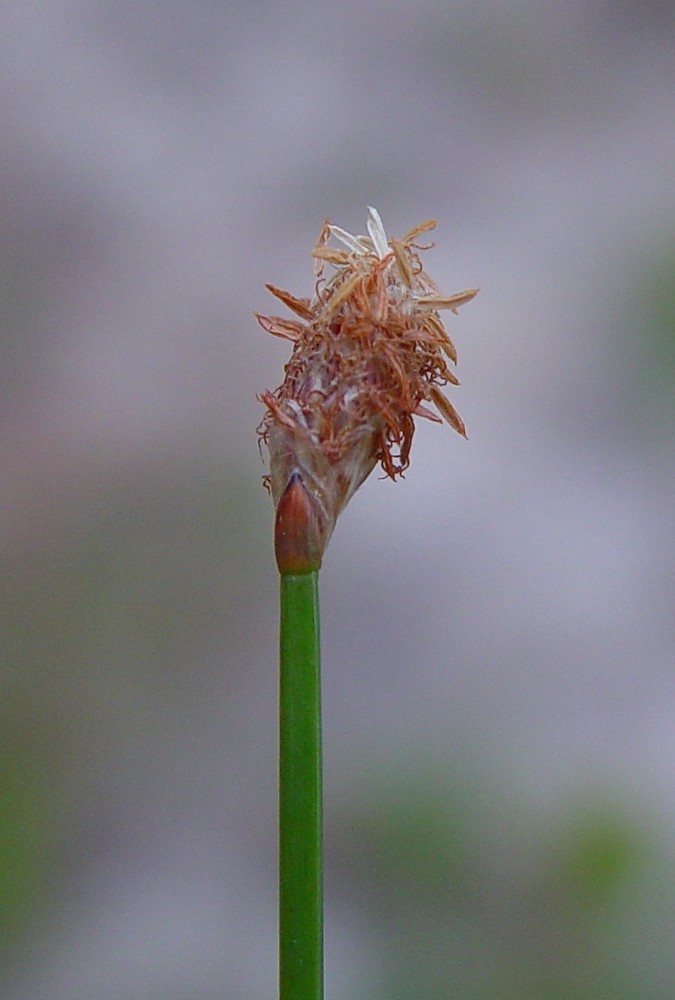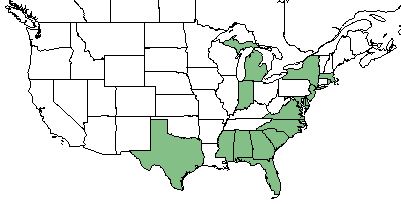Difference between revisions of "Eleocharis melanocarpa"
Emmazeitler (talk | contribs) |
|||
| Line 47: | Line 47: | ||
<!--==Diseases and parasites==--> | <!--==Diseases and parasites==--> | ||
| − | ==Conservation and | + | ==Conservation, cultivation, and restoration== |
This species is listed as endangered by the Maryland Department of Natural Resources, Natural Heritage Program, by the New Jersey Department of Environmental Protection and Energy, Office of Natural Lands Management, and by the Rhode Island Department of Environmental Management. It is also listed as threatened by the Indiana Department of Natural Resources, Division of Nature Preserves.<ref name= "USDA"/> Globally, ''E. melanocarpa'' is a G4 status since it is threatened by habitat fragmentation and land-use conversion.<ref>[[http://explorer.natureserve.org]] NatureServe Explorer. Accessed: May 3, 2019</ref> | This species is listed as endangered by the Maryland Department of Natural Resources, Natural Heritage Program, by the New Jersey Department of Environmental Protection and Energy, Office of Natural Lands Management, and by the Rhode Island Department of Environmental Management. It is also listed as threatened by the Indiana Department of Natural Resources, Division of Nature Preserves.<ref name= "USDA"/> Globally, ''E. melanocarpa'' is a G4 status since it is threatened by habitat fragmentation and land-use conversion.<ref>[[http://explorer.natureserve.org]] NatureServe Explorer. Accessed: May 3, 2019</ref> | ||
| − | == | + | ==Cultural use== |
==Photo Gallery== | ==Photo Gallery== | ||
<gallery widths=180px> | <gallery widths=180px> | ||
</gallery> | </gallery> | ||
==References and notes== | ==References and notes== | ||
Revision as of 14:43, 8 June 2021
| Eleocharis melanocarpa | |
|---|---|

| |
| Photo by © Arthur Haines, New England Wild Flower Society | |
| Scientific classification | |
| Kingdom: | Plantae |
| Division: | Magnoliophyta - Flowering plants |
| Class: | Liliopsida - Moncots |
| Order: | Poales |
| Family: | Cyperaceae |
| Genus: | Eleocharis |
| Species: | E. melanocarpa |
| Binomial name | |
| Eleocharis melanocarpa Torr. | |

| |
| Natural range of Eleocharis melanocarpa from USDA NRCS Plants Database. | |
Common names: Black-fruited spikerush, blackfruit spikerush[1][2]
Contents
Taxonomic Notes
Synonyms: none.[3]
Varieties: none.[3]
Description
E. melanocarpa is a perennial, monoecious, graminoid, sedge.[2] On its seed, the tubercle is very short and dilated with its projecting edge rolled over and surrounding the top of the nut.[4] The tips of the culms of E. melanocarpa often arch over and root in the substrate forming a dense tangle. [5] It commonly grows in stools containing several roots and five to 20 stems. Stems range in length from 1 to 3.6 ft (0.3 to 1.1 m) in length. Stools are commonly bunched together into clusters 1 ft (0.3 m) or more in diameter.[4]
Distribution
E. melanocarpa ranges from Massachusetts to Florida and Mississippi, disjunct to eastern Texas, southern Michigan, and northern Indiana. [2][5][1] Despite most studies not listing E. melanocarpa as occurring in Louisiana, the species has been found in parts of Bienville Parish in 2008 suggesting a more connective distribution along its southern range.[6][7] Its distribution is the classic view of overall coastal plain disjuncts distributions.[8]
Ecology
Habitat
E. melanocarpa is a facultative wetland species found in moist to wet ditches and freshwater pond margins,[9] wet pine savannas, and coastal plain bogs.[1] Such occurrences in these habitats are often ephemeral, sandy, and can range from sunny to shady.[6] More specifically, this species has been observed in dry loamy sand of open pinewoods, drying and muddy border of an open pond, drying loamy sand of slopes, sinkhole ponds, wet sand, and moist loamy sand at the edge of a pool.[10] It has been observed in standing water of at least 6 inches.[11] Unlike other coastal plain disjuncts, this species can become quite dominant in the habitats it is found.[8] However, it is still considered to be a rare plant species that is associated with the longleaf pine ecosystem.[12]
Associated species: Paspalum laeve, Paspalum setaceum, Rotala ramosior, Panicum hemitomon, Leersid hexandra, and Croton elliottii.[10]
Phenology
E. melanocarpa blooms during the months of June and July in more northern parts of its range[13] and in July through September in its southern range.[1]
Fire ecology
Despite typically inhabiting wet areas, fires from adjacent habitats (e.g. longleaf pine savannas, sandhill pines, old-field, etc.) are thought to burn into drawn-down areas of wet ponds/ditches. Such burns likely maintain more open canopy conditions benefiting populations of E. melanocarpa. [6]
Pollination
E. melanocarpa has no organs for attracting insects for pollination. Instead, it relies on the wind to disseminate pollen.[13]
Conservation, cultivation, and restoration
This species is listed as endangered by the Maryland Department of Natural Resources, Natural Heritage Program, by the New Jersey Department of Environmental Protection and Energy, Office of Natural Lands Management, and by the Rhode Island Department of Environmental Management. It is also listed as threatened by the Indiana Department of Natural Resources, Division of Nature Preserves.[2] Globally, E. melanocarpa is a G4 status since it is threatened by habitat fragmentation and land-use conversion.[14]
Cultural use
Photo Gallery
References and notes
- ↑ 1.0 1.1 1.2 1.3 Weakley A. S.(2015). Flora of the Southern and Mid-Atlantic States. Chapel Hill, NC: University of North Carolina Herbarium.
- ↑ 2.0 2.1 2.2 2.3 USDA, NRCS. (2016). The PLANTS Database (http://plants.usda.gov, 30 November 2017). National Plant Data Team, Greensboro, NC 27401-4901 USA.
- ↑ 3.0 3.1 Weakley, A.S. 2015. Flora of the southern and mid-atlantic states. Working Draft of 21 May 2015. University of North Carolina at Chapel Hill, Chapel Hill, North Carolina.
- ↑ 4.0 4.1 Hill E. J. (1894). Eleocharis melanocarpa a proliferous plant. Bulletin of the Torrey Botanical Club. 25(7):392-394.
- ↑ 5.0 5.1 Sorrie B. A. and Leonard S. W. (1999). Noteworthy records of Mississippi vascular plants. Sida 18:889-908.
- ↑ 6.0 6.1 6.2 Reid C. S. and Faulkner P. L. (2010). Louisiana. Castanea 75(1):138-140.
- ↑ Sorrie B. A. and Weakley A. S. (2001). Coastal plain vascular plant endemics: Phytogeographic patterns. Castanea 66(1/2):50-82.
- ↑ 8.0 8.1 Reznicek, A. A. (1994). "The disjunct coastal plain flora in the great lakes region." Biological Conservation 68: 203-215.
- ↑ Contributions to the flora of Florida: 8, Eleocharis (Cyperaceae). Castanea 40(1):16-36.
- ↑ 10.0 10.1 Florida State University Robert K. Godfrey Herbarium database. URL: http://herbarium.bio.fsu.edu. Last accessed: May 2019. Collectors: Loran C. Anderson, A. Gholson, Jr., Robert K. Godfrey, Melvin Jackson, J. M. Kane, Karen MacClendon, and Travis MacClendon. States and Counties: Florida: Calhoun, Jackson, Leon, Liberty, Wakulla, and Washington. Georgia: Baker and Thomas.
- ↑ Carr, L. G. (1940). "Further notes on coastal floral elements in the bogs of Augusta county, Virginia." Rhodora 42: 86-93.
- ↑ Walker, J. (1993). Rare vascular plant taxa associated with the longleaf pine ecosystems: Patterns in taxonomy and ecology. Tall Timbers Fire Ecology Conference, Tall Timbers Research Station, Tallahassee, FL.
- ↑ 13.0 13.1 Harper R. M. (1918). The vegetation of the Hempstead Plains. Proceedings of the semi-centennial anniversary of the Torry Botanical Club. Memoirs of the Torrey Botanical Club 17:262-286.
- ↑ [[1]] NatureServe Explorer. Accessed: May 3, 2019